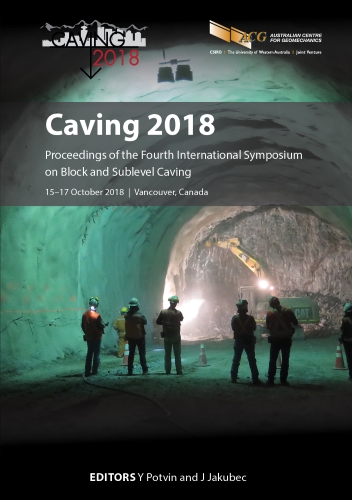Maximising resource utilisation in scheduling of underground mining works with multiple faces

|
Authors: Cortes, D; Martinez, Y; Silva, M |
DOI https://doi.org/10.36487/ACG_rep/1815_28_Cortes
Cite As:
Cortes, D, Martinez, Y & Silva, M 2018, 'Maximising resource utilisation in scheduling of underground mining works with multiple faces', in Y Potvin & J Jakubec (eds), Caving 2018: Proceedings of the Fourth International Symposium on Block and Sublevel Caving, Australian Centre for Geomechanics, Perth, pp. 399-406, https://doi.org/10.36487/ACG_rep/1815_28_Cortes
Abstract:
Scheduling of underground mining activities is based on the correct allocation of resources to ensure the fulfilment of the required physical advance of the project. In the case of mining tunnel construction, the scheduling of activities is based on three aspects – availability of required services of each unit operation (power, ventilation, industrial water, compressed air and drainage), availability of resources required (equipment and mining crew), and availability of faces for physical allocation and resource utilisation. In block caving mining projects, the development involved, particularly in the production level, is associated with multiple faces, which makes the allocation of resources complex compared to operations with isolated faces where resources are captive. Given the multiple face scenario, a scheduling model was generated based on the integration of the availability of the three aspects previously mentioned – faces, resources and services. These parameters are integrated in basic productive units (BPU), corresponding to entities defined by a certain quantity of available faces associated to a requirement of services, equipment and mining crew. These entities result in a rate of 300 to 350 m of mine tunnel development by month by each BPU. This model was developed and applied in the Chuquicamata Underground Project. The application of the model in mine scheduling allowed an increase of performance of the development by 78% per month in its first month of implementation instead of the 17% increase extrapolated from the trend to that date, allowing to reach a rate in range of 1,700 to 1,800 m per month.
Keywords: resource allocation, mine tunnel construction, block caving, Chuquicamata Underground Project
References:
Greberg, J & Sundqvist, F 2011, ‘Simulation as a tool for mine planning’, Proceedings of the Second International Future Mining Conference, The Australasian Institute of Mining and Metallurgy, Melbourne, pp. 273–278.
Salama, A & Greberg, J 2012, ‘Optimization of truck-loader haulage system in an underground mine: a simulation approach using SimMine’, Proceedings of MassMin 2012, Canadian Institute of Mining, Metallurgy and Petroleum, Westmount.
Wolgram, J, Li, Z & Scoble M 2012, ‘Application of simulation techniques in Oyu Tolgoi underground development scheduling’, Proceedings of MassMin 2012, Canadian Institute of Mining, Metallurgy and Petroleum, Westmount.
© Copyright 2026, Australian Centre for Geomechanics (ACG), The University of Western Australia. All rights reserved.
View copyright/legal information
Please direct any queries or error reports to repository-acg@uwa.edu.au
View copyright/legal information
Please direct any queries or error reports to repository-acg@uwa.edu.au
